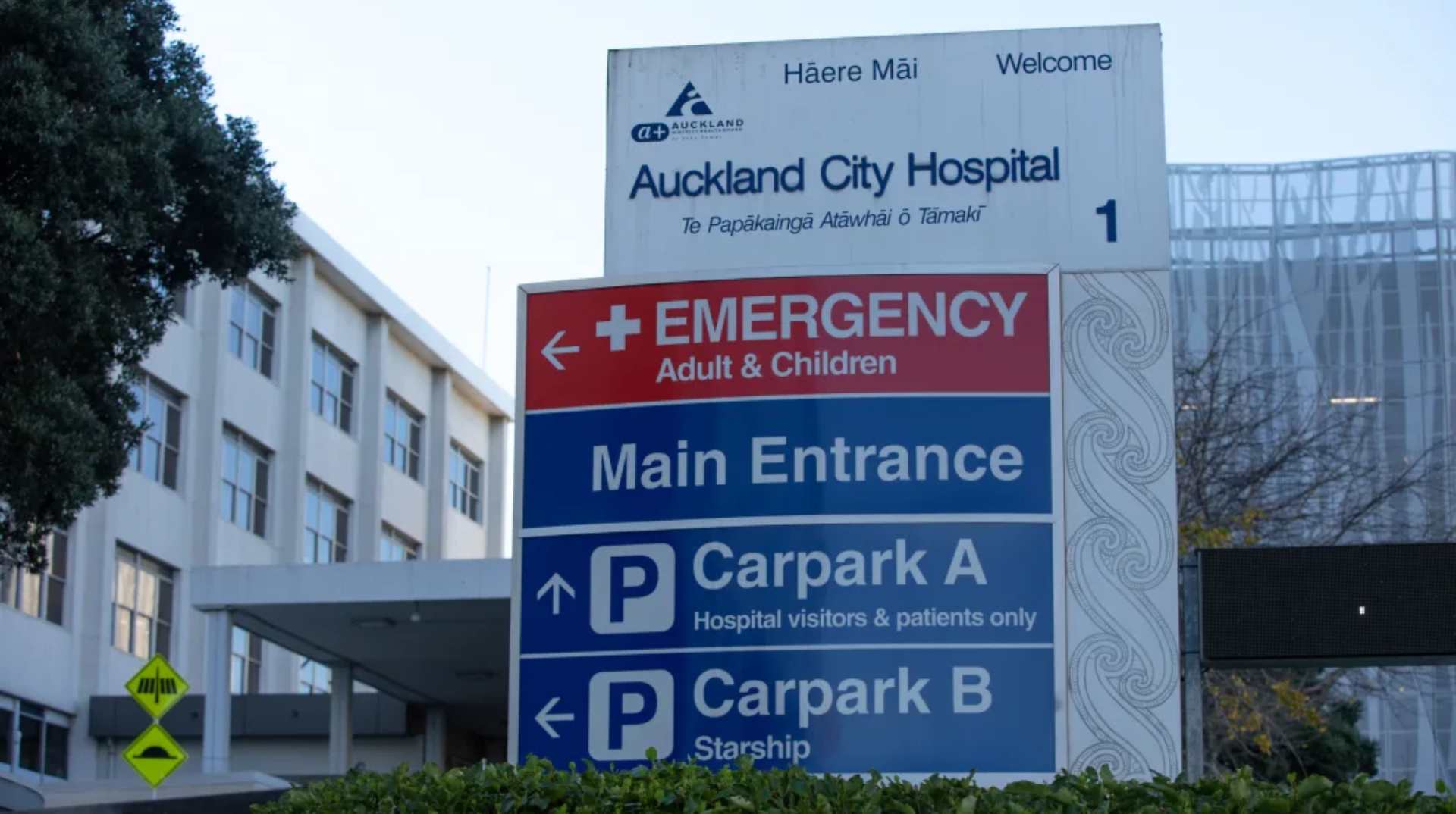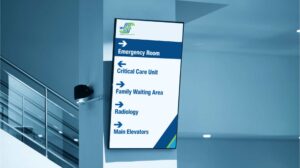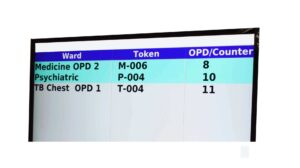
30 Apr 7 Benefits of Digital Signage in Healthcare
Information is crucial in healthcare . Messages need to be communicated effectively and clearly- whether they are to keep patients informed, to update staff in real-time, or to guide visitors around. Digital signage has been recognized as a formidable tool that enriches the patient and visitor experience, optimizes internal communication, and improves the overall efficiency of healthcare operations.
This guide aims to elaborate further on the most notable advantages of digital signage in the healthcare sector, its implementations, and trends that will shape the future of digital displays in healthcare environments.
Digital Signage in Healthcare Defined

Digital signage refers to electronic displays that present information, advertisements, or other messages to an audience. In healthcare, digital signage can serve a wide range of purposes including wayfinding, patient education, emergency notifications, and communicating to staff.
Typically, these digital systems employ LED or LCD displays, usually linked to a central content management system so that hospital administrators can update the information displayed on many screens in real time, providing flexibility and efficiency far beyond that found in traditional print media.
Digital Signage in Healthcare: Advantages in a Few Words
There are many advantages for healthcare companies in using digital signage. Here are some of the basic advantages that make it a crucial tool in modern healthcare:
1. Enhanced Wayfinding and Navigation
Large and disorienting hospitals and clinics can be a source of stress and anxiety for patients. For patients, visitors, and staff alike, wandering about a hospital can be quite a frustrating experience. Digital signage stops engaging confused patients by offering interactive navigation systems to guide people to their destinations inside the facility.
Key Features

Interactive maps: Through touchscreen kiosks, patients and visitors can enter a destination and get directions.
Digital directories: Signage that gives real-time notifications whereby people are guided to departments, clinics, or wards.
Multi-Language Options: Digital signage can be programmed for display directions in different languages, especially important in multicultural cities.
2. Communication with Patients in Real-Time
Waiting rooms are usually filled with patients becoming impatient since they are uncertain about wait times and reckon the status of appointments. Hospitals can update patients through digital signage to display wait times, appointment status, and upcoming procedures in real-time. This helps calm patients’ nerves; it makes them feel informed about the events happening in their visit.
Key Features:
Wait-time updates: Display an approximate wait time for each department or service area.
Appointment reminders: Displays to remind patients about their upcoming appointments or procedures.
Healthy news and tips: Keep your boards full of articles about health, wellness tips, preventive care, and announces about your hospital or healthcare facility.
3. Enhanced Staff Communication
Hospitals are fast moving, and staff needs to communicate with one another effectively and efficiently. One of the most common uses of digital signage on the inside is for key updates: whether you need to update shifts, let everyone know that a policy has changed or an emergency alert has been issued it’s all possible when you’ve got internal digital signage. This is to ensure that everyone is up to speed and can act immediately when an emergency situation arises.
Key Features:
Emergency alerts: Show live updates of an ongoing emergency, like a fire or natural disaster.
Shift schedules: Shift schedules or rosters for staff can be updated in real time.
Training aids: Show key training and best practice resources on screens throughout the hospital.
4. Patient Education and Health Promotion
HealthCare providers can utilize digital display to educate patients and support wellness. And in lobbies or exam rooms, digital displays can play videos with information on preventive care, postoperative care or a range of medical conditions. This type of data can be used to empower patients to manage their health and good adherence to treatments.
Key Features:
Interactive patient education: Screens that allow patients to interact with educational information about their condition or treatment.
Wellness initiatives: Digital signage can be leveraged to promote wellness programs, vaccinations and fitness programs that hospitals offer.
5. Reduced Perceived Wait Times
Waiting times are an issue for some patients, but one of the best things that can be done to alleviate the perception of a long wait, is by keeping patients entertained and informed while they wait. Using

digital signage to adds interest with
entertaining content like videos, news, or even games will make waiting feel faster.
Key Features:
Entertainment: Play movies, series, or health education material to entertain patients waiting.
Patient education: Patients can interact with content, for example answering quizzes or consuming educational information, using digital screens.
Real-time updates: Inform patients of the status, and changes, of their appointment so they get less frustrated.
6. Crisis Management and Emergency Notifications
 Hospitals must promptly and effectively convey vital information to patients and staff during emergencies. When it comes to disseminating crisis management information and emergency alerts, digital signage is essential. Digital signage can be used to show evacuation routes, safety procedures, and emergency instructions in real time during an emergency.
Hospitals must promptly and effectively convey vital information to patients and staff during emergencies. When it comes to disseminating crisis management information and emergency alerts, digital signage is essential. Digital signage can be used to show evacuation routes, safety procedures, and emergency instructions in real time during an emergency.
Key Features
Instant alerts: Send safety instructions or emergency alerts to every digital sign screen in the building.
Plans for evacuation: Show emergency contacts and interactive evacuation routes. During public health emergencies, such as pandemics or natural disasters, use signage to convey important information.
7. Endorsing Medical Specialities and Services
Digital signage is a useful tool for healthcare organisations to advertise their services, highlight new technologies or treatments, and advertise speciality clinics. This enables the hospital to connect with patients who might not be aware of all the services that are accessible to them.
Key Features
Promoting hospital services: Use digital displays to draw attention to specialised services like cardiology or dermatology.
Branding: Highlight the hospital’s accomplishments, including accolades and accreditations, and strengthen its brand with digital signage.
Video testimonies: If a patient can give video testimonials who have profited from the hospital’s services ,then it can be shown.
How to Implement Digital Signage in Your Healthcare Facility
It takes careful planning and the appropriate equipment to implement digital signage in a healthcare setting. Here’s a detailed how-to for getting started:
Step 1: Determine Your Goals
It is essential to set your goals before you start implementing digital signage. You aim to reduce waiting periods and improve communication among staff members and navigation for patients. Your goals will serve to guide your selection of software, hardware and content systems.
Step : 2 comprises selection of both right software and appropriate hardware platforms.
The components that form digital signage systems consist of content management systems for software and displays along with kiosks as hardware units. These tools require specific elements in your selection process.
The system needs to receive testing which confirms it integrates properly with existing software components and the hospital’s present IT framework.
Step 3: Create Interesting Content
Modern-day digital signage requires excellent content prominent in every process. Develop content which educates viewers through visually pleasing design formats that serve the target audience best. Your goal should be to develop brief information which can easily be understood by your audience.
Step 4: Strategically Position Displays
Digital signage displays need properly chosen positions to achieve their intended impact. The hospital should place digital displays at strategic areas that receive heavy traffic flow beginning with waiting rooms followed by lobbies and hallways. The audience should be able to read digital content no matter where they stand.
Step 5 : Monitor the system also implement enhancements
Monitoring the functionality of your digital signage system becomes important right after its installation. Implement analytic software systems which track the performance of content then allow you to implement required changes.
Conclusion: Using Digital Signage to Revolutionise Healthcare
Digital signage is a comprehensive solution that can increase operational efficiency, streamline communication, and improve patient satisfaction in healthcare settings. It is more than just a tool for displaying information. Hospitals can create a more contemporary, interesting, and patient-centered experience that meets the demands of today’s tech-savvy population by implementing digital signage.
Digital signage will become more and more significant in influencing patient experiences and promoting operational excellence as healthcare continues to change. Now is the perfect time to install digital signage in your establishment if you haven’t already.

No Comments